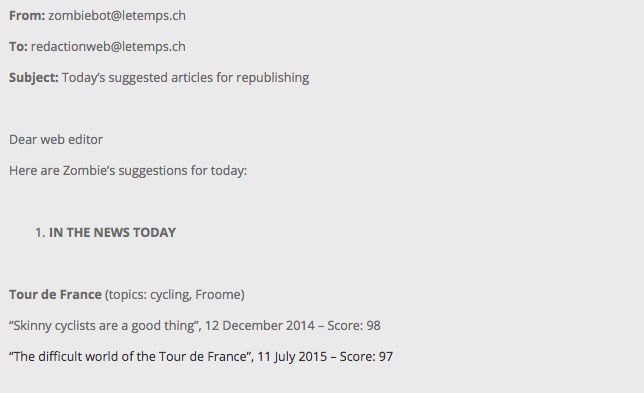Publishers have been reposting their old articles for years, but now the tools available to them are getting more sophisticated.
Swiss news publisher Le Temps has a whimsically named Project Zombie that notifies the editor, via Slack bot or email, which articles will do well if they are published again on the site or social media.
“The idea is to double up the tools to extract older articles with the potential of still doing well, giving a second life to those that deserve it,” said Yannick Rochat, a data scientist from the University of Lausanne who’s working on the project. The project, which will be open source, received €45,000, ($47,800) from Google’s Digital News Initiative last November.
Le Temps publishes about 70 articles a day. The publisher has built a database of 100,000 articles dating back to 1998, which it’s now in the process of classifying. For this, it needs to know three things: what topics and people the articles are talking about; how well the article originally performed, using data from Google Analytics and Chartbeat on pageviews, dwell time, comments and shares; and what’s trending now, using data from Google Trends, Google News and Twitter. Using this information, Le Temps calculates a relevancy score out of 100 for each article.
For instance, during the 2015 Tour de France, Le Temps published an article about the irregular and unreliable nature of professional cycling. It was read by 50,000 people, who spent on average more than three minutes with it. It was shared 5,000 times and generated 1,800 comments on Facebook. Zombie gave the article a score of 97.
Ad position: web_incontent_pos1

In the past, publishers have reposted old content as if they were new, raising ethical questions. Le Temps’ republished articles will bear the original time stamp. Jean Abbiateci, Le Temps’ editor-in-chief and project lead, is manually looking at Chartbeat and Google Analytics data and reposting older articles on Twitter with the tag “Article zombifié” (“Zombified Article”).
Already, Le Temps has reposted evergreen pieces such as one about a cat wearing a GPS device and another linking cannabis to aggressive behavior. They were chosen for their mix of humor, focus on specific groups of people and instructional content. Le Temps noticed similar types of articles consistently ranked most read on the site, despite being three years old.
Ad position: web_incontent_pos2
Le Temps is taking a cue from Vox, which published results of an experiment it ran in December 2014 where journalists updated and republished stories over a week. It’s also taking inspiration from NPR’s Carebot project for assigning relevance to articles. The Financial Times has also been focused on this, creating a dashboard that identifies what articles from 2015 and 2016 are performing well on social, search or on the site itself so they can be republished.
Rochat sees the potential for the Zombie project to feed other initiatives, too. Sentence length could be linked to article performance, for example. “Science is meeting journalism; journalism is using more and more scientific methods,” he said.
By June, the project should be completed, with editors receiving daily messages on which articles to republish. It’s complicated by the fact that while Le Temps is published in French, the project needs to understand English to mine platforms for current trends, and also translate some Swiss German and Swiss Italian content.
“With language, it’s difficult to get 100 percent accuracy,” he said.

Image: Denis Balibouse, for Reuters, via Le Temps, Facebook.
More in Media

NewFronts Briefing: Samsung, Condé Nast, Roku focus presentations on new ad formats and category-specific inventory
Day two of IAB’s NewFronts featured presentations from Samsung, Condé Nast and Roku, highlighting new partnerships, ad formats and inventory, as well as new AI capabilities.

The Athletic to raise ad prices as it paces to hit 3 million newsletter subscribers
The New York Times’ sports site The Athletic is about to hit 3 million total newsletter subscribers. It plans to raise ad prices as as a result of this nearly 20% year over year increase.

NewFronts Briefing: Google, Vizio and news publishers pitch marketers with new ad offerings and range of content categories
Day one of the 2024 IAB NewFronts featured presentations from Google and Vizio, as well as a spotlight on news publishers.
Ad position: web_bfu